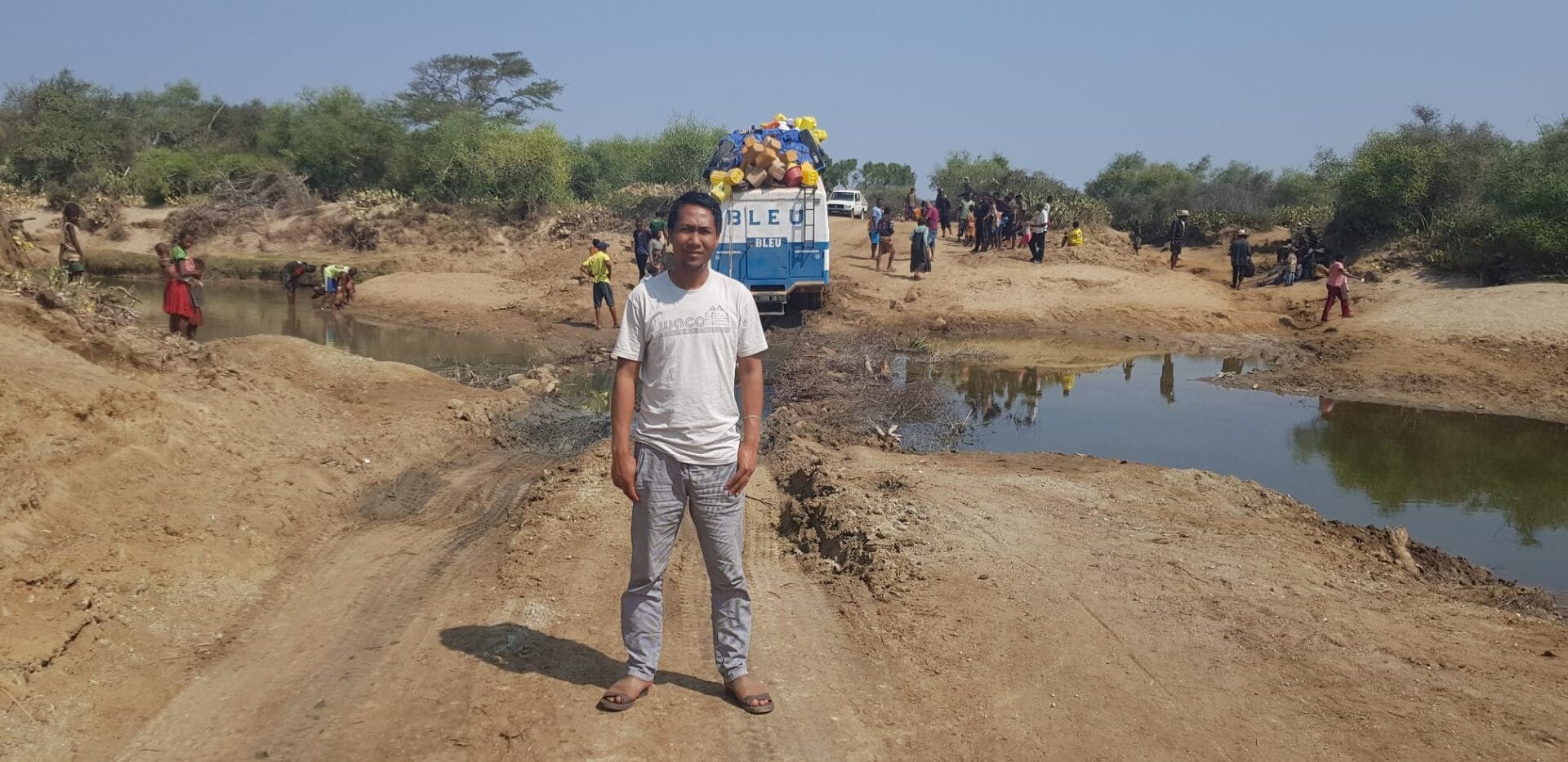As part of a partnership with the United Nations Clinics, we trained their staff in southern Madagascar, spread across four sites : Ampanihy, Ambovombe, Fort-Dauphin, and Betroka.
Crossing southern Madagascar
During this trip, we took three different national roads from Antananarivo. The experience was both tiring and surprising, but very rich in discoveries.
RN7 : Antananarivo – Toliary
For the first two days, we took the RN7 to Toliary, passing through Fianarantsoa. Although some sections are currently being upgraded, the road remains difficult in several places.
In Ambatolampy (between Antsirabe and Antananarivo), the government has signed a contract with a company to rebuild the road, but during the day, when the machinery is in operation, traffic becomes one-way. Cars coming from the other direction sometimes have to wait a long time before they can pass. Interestingly, people living nearby take advantage of this to sell food to the stopped cars. The road turns into a large, lively market, almost like an impromptu party. It’s a new way for locals to earn a little money.
RN10 and RN13 : Toliary – South
After Toliary, we took the RN10 and RN13, and there… it was a disaster. There is no asphalt, so you either drive on sand or on rocks. There is no clear road, but lots of tracks that change depending on the condition of the terrain. You have to choose the one that seems the least bad, but they all lead to the same destination.
One detail that really struck me was seeing lots of armed people along the road, not soldiers, but shepherds or zebu herders, armed with rifles.
In the south, dahalo (zebu thieves) are still very present. They can not only steal herds, but also attack cars traveling through isolated areas such as the cactus forest. That’s why it’s very risky to drive after 6.00 p.m. Everyone avoids driving at night, except for bush taxis, but they are often armed, with a rifle sitting right next to the driver.
This trip showed me how beautiful Madagascar is, but also how challenging, especially when it comes to the roads. Every journey can become an adventure. You have to be patient, careful, but also open to what you discover along the way.

Culture, beliefs, and realities : another side of Madagascar
During this trip, we traveled through regions inhabited by three main ethnic groups: the Tanosy, the Antandroy, and the Mahafaly. These are peoples with very rich traditions that are not often seen in large cities.
In the middle of the RN13, we came across a funeral ceremony. The body of the deceased was being carried on foot, accompanied by traditional dances in the middle of the road. As there was no way around it, we had to stop. What really surprised me was that they demanded money from us in order to continue the funeral, blocking the road until we gave them something. This reflects a certain form of precariousness, where even death becomes dependent on the solidarity of passersby.
Among the Mahafaly and Antandroy peoples, funerals don’t end there. They are also great sculptors. Frankly, I have never seen such impressive tombs anywhere else in Madagascar. Some are over 300 square meters in size, decorated with carved wood, zebu skulls, or drawings representing what the person loved in their life. It’s not just a tomb, it’s a work of art and a tribute to a whole life. I was told that the more skulls there are, the more it shows that the family is rich, respected, and generous. It’s a real source of local pride.

But behind this cultural richness lies a very harsh reality: water scarcity. This region is dry, arid, and full of thorns, which is where the name Antandroy comes from, meaning “the people of the thorns ». One scene stuck with me: we came across a broken-down bush taxi in a kind of dry riverbed that we had to cross. There was barely any water left. While we waited, the passengers got out. Some washed their faces, others brushed their teeth, others relieved themselves right there, and even washed their private parts. All in the same small puddle of water. Frankly, I was both moved and shocked.

Even in cities like Ambovombe, the water is not clean; it tastes bland and contains a lot of lime. I learned this the hard way: I got severe diarrhea after drinking it.
Southern Madagascar is rich in tradition and history, but neglected in terms of basic needs. There is a shortage of water and the roads are impassable, but the people retain their dignity and keep their culture alive.
… To a paradise location
Despite the terrible state of the roads in southern Madagascar, this adventure led me to a true paradise: Fort-Dauphin.
After a stop in Ambovombe, we hit the road for Fort-Dauphin. That weekend, I got to see some really beautiful scenery: breathtaking beaches, unspoiled nature, and, most of all, a peaceful vibe that was a total contrast to the hustle and bustle of traveling. It was my first time in that area, and I was amazed by everything. I had never seen such large oysters! On Sunday, we went to the beach, and the locals prepared a meal for us: a feast of grilled shellfish, cooked on the spot, with touching simplicity and generosity. It was also my first time tasting lobster. I didn’t even know what it was called, which made the team laugh, and that moment of sharing has remained etched in my memory.

In the end, even though the mission was physically demanding due to the length of the journey and the condition of the roads, it will remain one of the most memorable experiences of my life: a human adventure, discoveries, and unforgettable memories.
Ny Ony, Doctor and First Aid Trainer at AiNA soa
